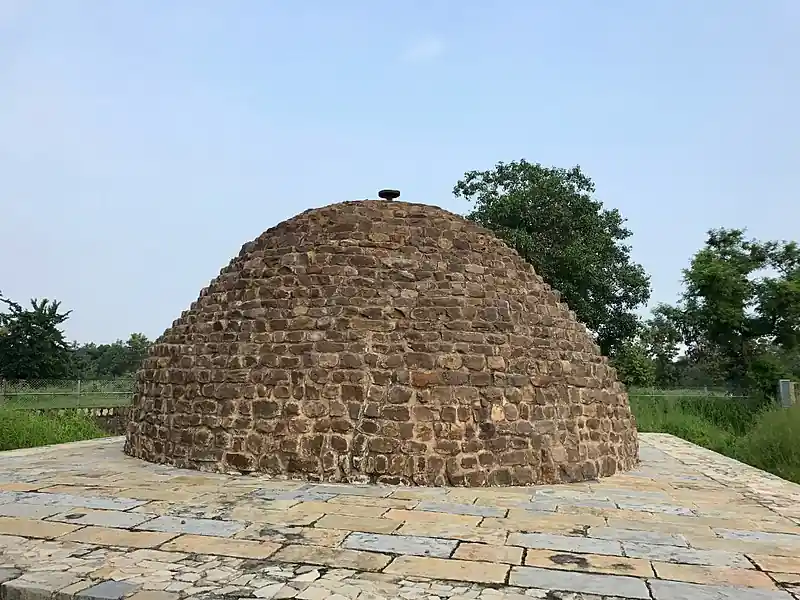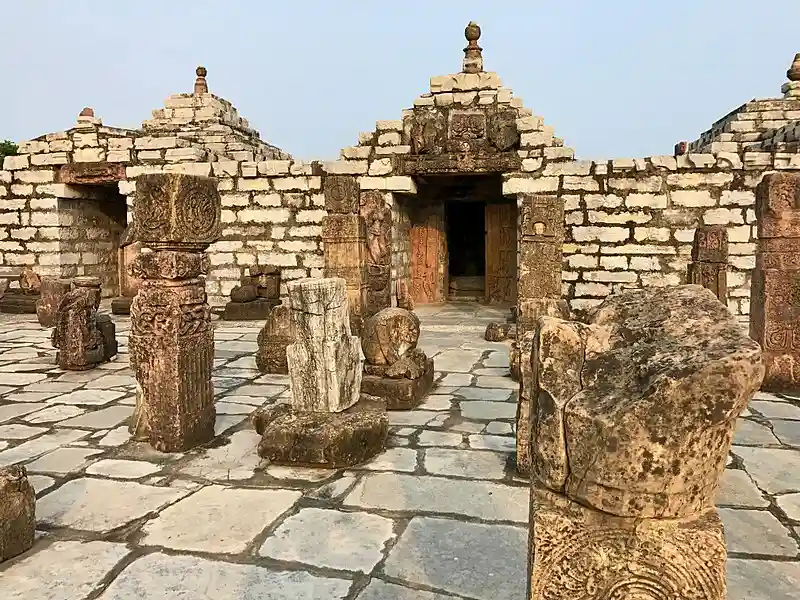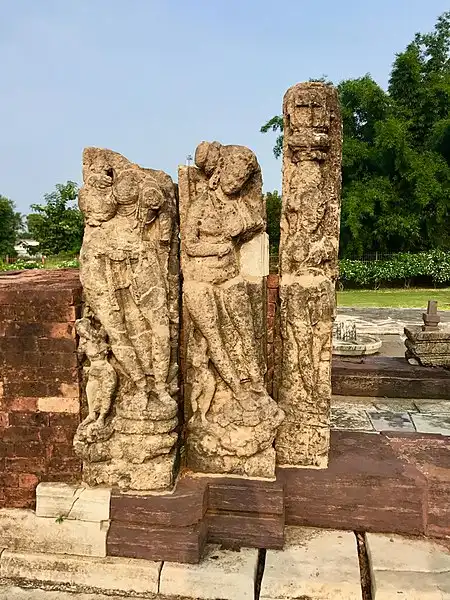Sirpur, located in the Mahasamund district of Chhattisgarh, Nestled on the banks of the serene Mahanadi River, is a quaint town that offers a unique blend of ancient history, spiritual significance, and natural beauty. This hidden gem is not only a pilgrimage site but also a hub for nature lovers and adventure seekers.
In this post, we will delve into the fascinating history of This Site, explore its iconic temples and monuments, and discover the vibrant local culture that continues to thrive.

History and Lesser-Known Facts About Sirpur, Chhattisgarh
Sirpur, a historical village in Chhattisgarh, is renowned for its rich cultural heritage and archaeological significance. While many are familiar with its prominent Buddhist Stupa and temples, several lesser-known facts add depth to its historical narrative.
Ancient Capital of Dakshina Kosala
Sirpur served as the capital of the Dakshina Kosala kingdom, particularly under the reigns of the Sharabhapuriya and Panduvanshi dynasties. This status allowed it to flourish as a center of commerce, culture, and spirituality from the 5th to the 12th centuries CE. The town was not just a political hub but also a vibrant center for various religious practices, including Buddhism, Hinduism, and Jainism, showcasing a unique blend of cultures.
Home to a Large Monastic Community
At its peak, Sirpur was home to approximately 10,000 Mahayana Buddhist monks residing in around 100 monasteries. This significant population underscores the town’s role as a major center for Buddhist learning and practice in ancient India. The presence of such a large monastic community indicates that Sirpur was a pivotal site for the dissemination of Buddhist teachings and philosophies.
Influence of Hieun Tsang
The famous Chinese traveler and Buddhist monk Hieun Tsang visited Sirpur in the 7th century CE. His accounts highlight the region’s prosperity and the benevolence of its rulers towards Buddhism. He described Sirpur as a thriving kingdom with a rich cultural life, where various religious traditions coexisted harmoniously. His observations provide valuable insights into the historical significance of Sirpur during this period.
Archaeological Discoveries
Recent excavations have revealed a wealth of archaeological treasures, including 17 Shiva temples, 8 Buddhist viharas, and 3 Jain viharas. These findings illustrate the diverse religious landscape of Sirpur and its importance as a pilgrimage site. The excavations have also uncovered a massive market complex, indicating that Sirpur was a bustling trade center, attracting merchants from various regions.
Oldest Buddha Viharas
The Buddha Viharas in Sirpur are considered older than those in Nalanda, highlighting the town’s early and significant role in the spread of Buddhism in India.
Cultural Melting Pot
Sirpur was a melting pot of various religious traditions. Inscriptions and historical records reveal the presence of Brahmanical, Saivite, Vaisnavite, Buddhist, and Jain sites, reflecting the town’s cultural diversity.
Artistic Heritage
The town’s monuments are adorned with intricate carvings and sculptures. An 8th-century artwork depicting a kissing couple is one of the notable discoveries, showcasing the artistic excellence of the period.
The Role of Natural Resources
Sirpur’s location along the banks of the Mahanadi River contributed significantly to its prosperity. The river not only provided essential resources for agriculture but also facilitated trade and commerce. The presence of lakes and ponds around the region further enhanced its agricultural productivity, making it an attractive settlement for various communities.

Impact of Earthquake in the history of Sirpur
The earthquake in the 12th century CE had a profound impact on the history of Sirpur, marking a significant turning point for this once-thriving center of culture and spirituality.
Destruction and Burial
The earthquake is believed to have caused widespread destruction in Sirpur, burying many of its monuments and structures under mud and debris.
This catastrophic event effectively led to the town’s decline, as it not only damaged the physical infrastructure but also disrupted the social and economic fabric of the community.
As a result, Sirpur fell into obscurity, transitioning from a bustling capital of the Dakshina Kosala kingdom to a forgotten site.
Loss of Cultural Significance
Prior to the earthquake, Sirpur was a prominent center for Buddhism, Hinduism, and Jainism, attracting scholars, monks, and pilgrims.
The earthquake contributed to the decline of Buddhist influence in the region, as many monasteries were abandoned or repurposed for other religious practices.
The cultural and religious diversity that had characterized Sirpur began to wane, leading to a homogenization of religious practices as Buddhism lost its prominence.
Archaeological Rediscovery
It wasn’t until the late 19th century that Sirpur began to regain attention, thanks to archaeological efforts. The site was largely hidden and neglected until excavations started revealing the remnants of its glorious past.
The earthquake had preserved many artifacts and structures under layers of sediment, which helped archaeologists uncover significant historical treasures, including temples, monasteries, and sculptures.
Continued Exploration and Significance
The earthquake’s aftermath left Sirpur in a state of dormancy for centuries, but the ongoing archaeological work has gradually restored its historical significance.
Excavations conducted in the early 2000s unearthed numerous Buddhist and Hindu monuments, revealing that only a fraction of Sirpur’s treasures had been discovered. This resurgence of interest has led to a renewed appreciation for Sirpur’s cultural heritage, emphasizing its role in the broader historical narrative of ancient India.
Despite the devastation, the ruins of Sirpur continue to attract historians, archaeologists, and tourists, offering a glimpse into its rich past and the resilience of its cultural heritage.
In Summry, Sirpur’s rich history and cultural heritage make it a fascinating destination for anyone interested in exploring India’s ancient past. Its well-preserved monuments and diverse religious sites offer a unique glimpse into the region’s historical significance.

Archaeological Sites in Sirpur, Chhattisgarh
Sirpur, located in the Mahasamund district of Chhattisgarh, India, is a treasure trove of archaeological wonders that reflect the region’s rich cultural and historical heritage. The site is home to numerous monuments and structures that date back to the 5th to 12th centuries CE, showcasing the influence of Buddhism, Hinduism, and Jainism. Here’s a detailed look at the most significant archaeological sites in Sirpur.
Lakshman Temple
The Lakshmana Temple in Sirpur, built in the early 7th century CE, is a well-preserved Hindu monument dedicated to Lord Vishnu.
It showcases the architectural prowess of the Kosala dynasty period, with brick construction and stone carvings. The temple features a raised platform, a sanctum facing east, an antarala, and a mandapa.
Intricate carvings of Hindu deities and motifs adorn the exterior, including Anantasayana Vishnu and scenes from the Bhagavata Purana. Believed to have been constructed by Queen Vasata, the temple highlights religious syncretism with Shaiva and Shakti motifs.
Restoration efforts have been made to preserve the temple, including rebuilding steps and maintaining the intricate reliefs on the exterior walls. The temple is one of the earliest monuments in Sirpur and reflects the historical and cultural significance of the region.
Surang Tila
Surang Tila is another significant archaeological site in Sirpur, believed to be where the Chinese traveler Xuanzang (Hieun Tsang) stayed during his pilgrimage in the 7th century. This site features a complex of ancient structures, including a large stupa and remnants of monastic cells, indicating its historical significance as a Buddhist monastery.
Buddha Viharas
Sirpur is home to ten Buddhist viharas, which served as monasteries for Buddhist monks. These viharas are characterized by their spacious layouts and are adorned with exquisite stone carvings. One of the viharas is noted to be four times larger than the famous Nalanda University, showcasing the region’s historical importance in Buddhist education.
Shiva Temples
The site boasts 22 Shiva temples, each showcasing unique architectural styles and artistic expressions. Among these, the Gandeshwar Temple is particularly noteworthy, dedicated to Lord Shiva. The temples exhibit intricate carvings and sculptures, reflecting the artistic prowess of the period.
Jain Viharas
In addition to Buddhist structures, Sirpur has three Jain viharas, which highlight the coexistence of different religious traditions in the region. These viharas contain carvings and inscriptions that provide insights into Jain philosophy and practices.
The Ancient Market Complex
Excavations have revealed the remains of an ancient market complex, which is believed to be one of the largest of its kind in the region. This market was likely a bustling center of trade and commerce, facilitating economic interactions among various communities.
Ayurvedic Spa and Bathhouse
Among the fascinating discoveries is a 6th-century Ayurvedic bathhouse, known as the Ayurvedic Snaan Kund. This structure indicates the advanced understanding of health and wellness in ancient Indian society. The presence of such facilities suggests that Sirpur was not only a religious and cultural hub but also a center for health and wellness practices.
The Palace Complex
Excavations have uncovered a sprawling palace complex, which is believed to have been the residence of local chieftains. This complex includes multiple residential structures, indicating the social hierarchy and lifestyle of the ruling class during that period.
Tivaradeva Mahavihara
This recently excavated Buddhist monastery is considered one of the most stunning finds in Sirpur. The sanctum houses a remarkable sculpture of the Buddha in the “Bhumisparsha mudra” (earth-touching gesture). The Tivaradeva Mahavihara is believed to be one of the largest and most important Buddhist monasteries in India.
Ananda Prabhu Vihara
The Ananda Prabhu Vihara is a significant Buddhist site in Sirpur. This vihara, or monastery, reflects the influence of Mahayana Buddhism in the region and is known for its serene ambiance and historical importance.
Swastika Vihara
The Swastika Vihara is an intriguing archaeological site that provides insights into the spiritual practices of ancient Buddhist monks. It is named after the swastika symbol found carved on the walls, which was an auspicious sign in Buddhist iconography. The vihara was likely used for meditation and religious discourses.
Underground Granary Market
Excavations have revealed an extensive underground granary market in Sirpur, which was likely used for storing and trading agricultural produce. This unique structure provides insights into the town’s economic activities and the lifestyle of its inhabitants during the 5th-12th centuries.
Baleshwar Temple Complex
The Baleshwar Temple Complex was believed to be lost under debris until it was recently excavated. It is named after the great king Mahashivgupt Balarjun, who is credited with its construction. The complex features several small shrines dedicated to Lord Shiva, as well as a unique rock painting of Ongna.
These sites, showcase the rich archaeological heritage of Sirpur and its significance as a center of Hindu, Buddhist, and Jain culture during its heyday.

Visiting Sirpur, Chhattisgarh: A Comprehensive Travel Guide
Sirpur, located in the Mahasamund district of Chhattisgarh, India, is a treasure trove of history, culture, and spirituality. Known for its ancient ruins and serene landscapes, it offers a unique experience for travelers.
This guide will provide you with essential information on how to visit Sirpur, including travel modes, festivals, entry fees, accommodation, nearby attractions, and the best time to visit.
How to Reach Sirpur
By Air: The nearest airport is Swami Vivekananda Airport in Raipur, approximately 78 kilometers from Sirpur. From the airport, you can hire a taxi or take a bus to reach Sirpur.
By Train: Sirpur does not have its own railway station, but the nearest major station is Mahasamund, about 35 kilometers away. From Mahasamund, you can take a taxi or local transport to Sirpur.
By Road: Sirpur is well-connected by road. You can drive or take a bus from Raipur or other nearby cities. The roads are generally in good condition, making it a pleasant journey through the scenic landscapes of Chhattisgarh.
Festivals and Rituals
Sirpur is known for its vibrant festivals that reflect the rich cultural heritage of the region. Notable festivals include:
Buddha Jayanti: Celebrated with great enthusiasm, this festival marks the birth of Lord Buddha and includes prayers, processions, and cultural performances.
Music and Dance Festival: Organized by the Chhattisgarh Tourism Board, this festival takes place in February and showcases traditional music and dance, promoting the region’s Buddhist heritage.
Local Festivals: Sirpur also celebrates various local festivals, including Teeja, Hareli, and Pola, which highlight the agricultural traditions and tribal culture of Chhattisgarh.
Opening Times and Entry Fees
Most archaeological sites and temples in Sirpur are open to visitors from 6:00 AM to 6:00 PM. Entry fees vary by site, but many temples and ruins do not charge an entry fee, making it accessible for all travelers.
Best Time to Visit
The ideal time to visit is during the winter months, from October to March. The weather is pleasant, making it perfect for exploring the historical sites and enjoying outdoor activities. Avoid visiting during the summer months (April to June) when temperatures can soar.
Accommodation
While Sirpur has limited accommodation options, the Hiuen Tsiang Resort, run by the Chhattisgarh Tourism Board, is the best choice for travelers. Located close to the archaeological sites, it offers comfortable rooms at reasonable rates. Other local guesthouses may also be available, but options are limited.
Homestays: For a more authentic experience, consider staying at a local homestay.
Nearby Attractions
Sirpur is surrounded by several attractions that enhance your travel experience:
Dhaskund Waterfall: A picturesque waterfall, ideal for picnics and relaxation, especially during the monsoon season.
Barnawapara Wildlife Sanctuary: Located about 45 kilometers from Sirpur, this sanctuary is a haven for wildlife enthusiasts, home to species like the Indian bison, cheetal, and sambhar.
Raipur: The capital city of Chhattisgarh, Raipur offers modern amenities and attractions such as the Mahant Ghasidas Memorial Museum and the Nandan Van Zoo.
Turturiya: An ancient Buddhist site located about 30 kilometers from Sirpur, known for its scenic beauty and historical significance.
Mahanadi River: The scenic river offers opportunities for relaxation and nature walks.
Mahasamund: A nearby town with additional attractions, including local markets and cultural sites.
Additional Tips:
Carry plenty of water, especially during the summer months.
Carry comfortable footwear as you’ll be doing a lot of walking.
Respect the local customs and traditions.
Bargain when purchasing souvenirs or handicrafts.
Carry sufficient cash as not all places accept cards.
Hire a local guide to learn more about the history and culture of Sirpur.
By following this guide, you can plan a memorable trip and discover its rich history and culture.
- Sun Temple Mahoba: A angelic Marvel in Bundelkhand
- Shri Satyanarayan Tulsi Manas Mandir, Varanasi: Holy Bliss
- Jambukeswarar Temple, Thiruvanaikaval: The Sacred Oasis͏
- Ambernath Shiv Mandir, Maharashtra: A Timeless Treasure
- Ganesh Tok: A Spiritual Sojourn Amidst the Clouds
Conclusion
Sirpur, with its rich tapestry of history, culture, and spirituality, stands as a testament to India’s ancient heritage. This hidden gem in Chhattisgarh offers a unique blend of architectural marvels, from the intricate carvings of the Lakshmana Temple to the serene Buddhist viharas. The town’s vibrant festivals and rituals, coupled with its fascinating legends, add to its allure.
Visiting Sirpur is not just a journey through time but an immersive experience that connects you with the spiritual and cultural essence of ancient India. Whether you’re exploring the underground granary market or marveling at the advanced urban planning of the sixth-century bathhouse, Sirpur promises an enriching and unforgettable adventure.
Plan your visit to Sirpur and uncover the stories etched in its stones, the harmony of its diverse religious sites, and the beauty of its natural surroundings. This ancient town awaits to share its secrets and splendor with those who seek to delve into its historical depths.
So, pack your bags, set your itinerary, and embark on a journey to discover the hidden treasures of This Site. Allow yourself to be captivated by its charm, and create memories that will linger long after you leave this magical place. Sirpur awaits you with open arms, ready to share its stories and secrets. Happy travel!